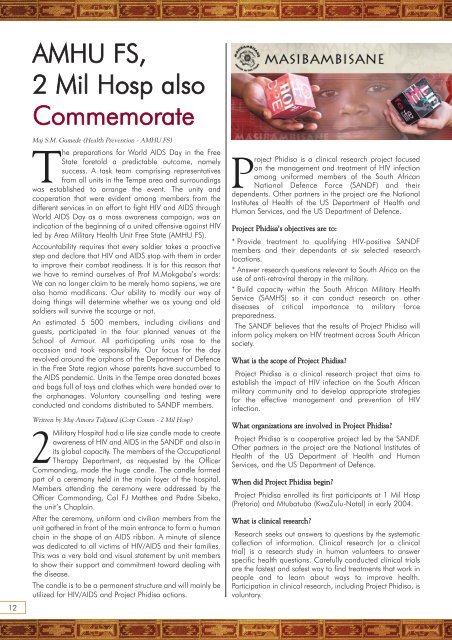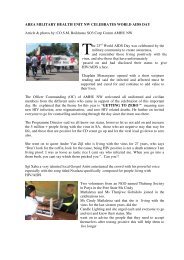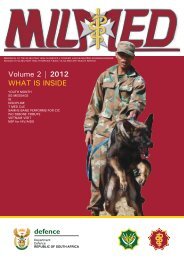MilMed Jan Feb 2007.qxp - SA Military Health Service
MilMed Jan Feb 2007.qxp - SA Military Health Service
MilMed Jan Feb 2007.qxp - SA Military Health Service
Create successful ePaper yourself
Turn your PDF publications into a flip-book with our unique Google optimized e-Paper software.
12AMHU FS,2 Mil Hosp alsoCommemorateMaj S.M. Gumede (<strong>Health</strong> Prevention - AMHU FS)The preparations for World AIDS Day in the FreeState foretold a predictable outcome, namelysuccess. A task team comprising representativesfrom all units in the Tempe area and surroundingswas established to arrange the event. The unity andcooperation that were evident among members from thedifferent services in an effort to fight HIV and AIDS throughWorld AIDS Day as a mass awareness campaign, was anindication of the beginning of a united offensive against HIVled by Area <strong>Military</strong> <strong>Health</strong> Unit Free State (AMHU FS).Accountability requires that every soldier takes a proactivestep and declare that HIV and AIDS stop with them in orderto improve their combat readiness. It is for this reason thatwe have to remind ourselves of Prof M.Mokgoba’s words:We can no longer claim to be merely homo sapiens, we arealso homo modificans. Our ability to modify our way ofdoing things will determine whether we as young and oldsoldiers will survive the scourge or not.An estimated 5 500 members, including civilians andguests, participated in the four planned venues at theSchool of Armour. All participating units rose to theoccasion and took responsibility. Our focus for the dayrevolved around the orphans of the Department of Defencein the Free State region whose parents have succumbed tothe AIDS pandemic. Units in the Tempe area donated boxesand bags full of toys and clothes which were handed over tothe orphanages. Voluntary counselling and testing wereconducted and condoms distributed to <strong>SA</strong>NDF members.Written by Maj Amora Taljaard (Corp Comm - 2 Mil Hosp)2<strong>Military</strong> Hospital had a life size candle made to createawareness of HIV and AIDS in the <strong>SA</strong>NDF and also inits global capacity. The members of the OccupationalTherapy Department, as requested by the OfficerCommanding, made the huge candle. The candle formedpart of a ceremony held in the main foyer of the hospital.Members attending the ceremony were addressed by theOfficer Commanding, Col FJ Matthee and Padre Sibeko,the unit’s Chaplain.After the ceremony, uniform and civilian members from theunit gathered in front of the main entrance to form a humanchain in the shape of an AIDS ribbon. A minute of silencewas dedicated to all victims of HIV/AIDS and their families.This was a very bold and visual statement by unit membersto show their support and commitment toward dealing withthe disease.The candle is to be a permanent structure and will mainly beutilized for HIV/AIDS and Project Phidisa actions.Project Phidisa is a clinical research project focusedon the management and treatment of HIV infectionamong uniformed members of the South AfricanNational Defence Force (<strong>SA</strong>NDF) and theirdependents. Other partners in the project are the NationalInstitutes of <strong>Health</strong> of the US Department of <strong>Health</strong> andHuman <strong>Service</strong>s, and the US Department of Defence.Project Phidisa's objectives are to:* Provide treatment to qualifying HIV-positive <strong>SA</strong>NDFmembers and their dependants at six selected researchlocations.* Answer research questions relevant to South Africa on theuse of anti-retroviral therapy in the military.* Build capacity within the South African <strong>Military</strong> <strong>Health</strong><strong>Service</strong> (<strong>SA</strong>MHS) so it can conduct research on otherdiseases of critical importance to military forcepreparedness.The <strong>SA</strong>NDF believes that the results of Project Phidisa willinform policy makers on HIV treatment across South Africansociety.What is the scope of Project Phidisa?Project Phidisa is a clinical research project that aims toestablish the impact of HIV infection on the South Africanmilitary community and to develop appropriate strategiesfor the effective management and prevention of HIVinfection.What organizations are involved in Project Phidisa?Project Phidisa is a cooperative project led by the <strong>SA</strong>NDF.Other partners in the project are the National Institutes of<strong>Health</strong> of the US Department of <strong>Health</strong> and Human<strong>Service</strong>s, and the US Department of Defence.When did Project Phidisa begin?Project Phidisa enrolled its first participants at 1 Mil Hosp(Pretoria) and Mtubatuba (KwaZulu-Natal) in early 2004.What is clinical research?Research seeks out answers to questions by the systematiccollection of information. Clinical research (or a clinicaltrial) is a research study in human volunteers to answerspecific health questions. Carefully conducted clinical trialsare the fastest and safest way to find treatments that work inpeople and to learn about ways to improve health.Participation in clinical research, including Project Phidisa, isvoluntary.







